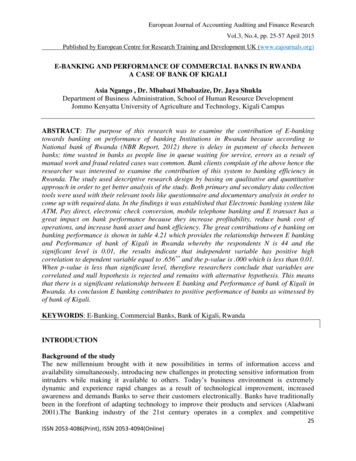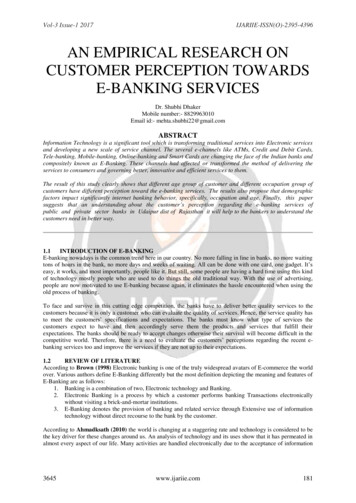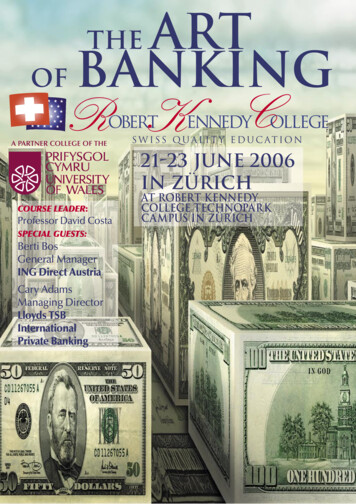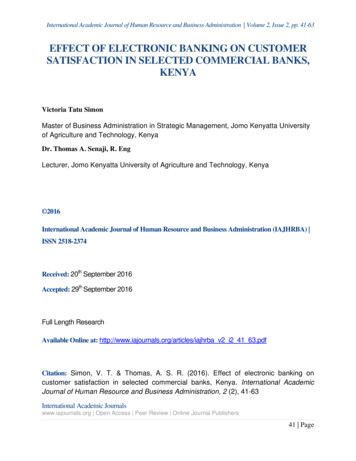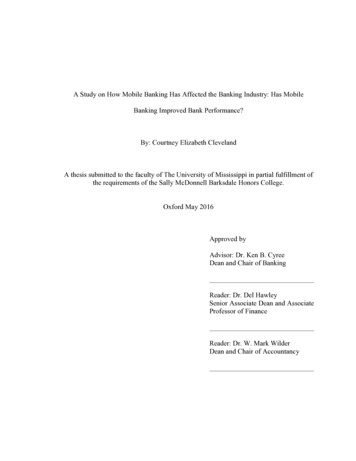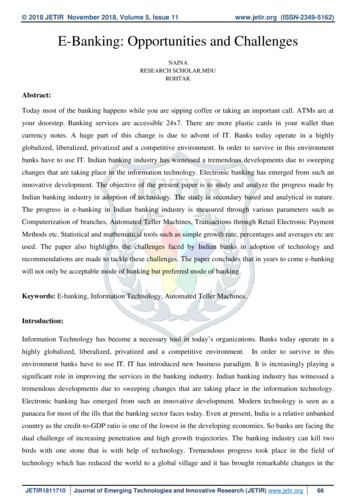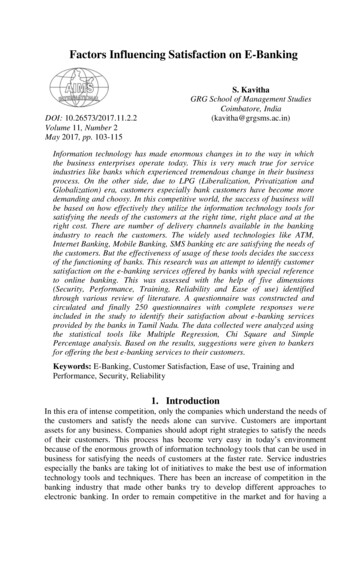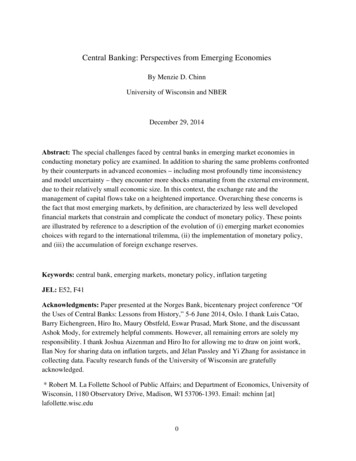
Transcription
Central Banking: Perspectives from Emerging EconomiesBy Menzie D. ChinnUniversity of Wisconsin and NBERDecember 29, 2014Abstract: The special challenges faced by central banks in emerging market economies inconducting monetary policy are examined. In addition to sharing the same problems confrontedby their counterparts in advanced economies – including most profoundly time inconsistencyand model uncertainty – they encounter more shocks emanating from the external environment,due to their relatively small economic size. In this context, the exchange rate and themanagement of capital flows take on a heightened importance. Overarching these concerns isthe fact that most emerging markets, by definition, are characterized by less well developedfinancial markets that constrain and complicate the conduct of monetary policy. These pointsare illustrated by reference to a description of the evolution of (i) emerging market economieschoices with regard to the international trilemma, (ii) the implementation of monetary policy,and (iii) the accumulation of foreign exchange reserves.Keywords: central bank, emerging markets, monetary policy, inflation targetingJEL: E52, F41Acknowledgments: Paper presented at the Norges Bank, bicentenary project conference “Ofthe Uses of Central Banks: Lessons from History,” 5-6 June 2014, Oslo. I thank Luis Catao,Barry Eichengreen, Hiro Ito, Maury Obstfeld, Eswar Prasad, Mark Stone, and the discussantAshok Mody, for extremely helpful comments. However, all remaining errors are solely myresponsibility. I thank Joshua Aizenman and Hiro Ito for allowing me to draw on joint work,Ilan Noy for sharing data on inflation targets, and Jélan Passley and Yi Zhang for assistance incollecting data. Faculty research funds of the University of Wisconsin are gratefullyacknowledged.* Robert M. La Follette School of Public Affairs; and Department of Economics, University ofWisconsin, 1180 Observatory Drive, Madison, WI 53706-1393. Email: mchinn [at]lafollette.wisc.edu0
“[T]o the gods we are as flies to wanton boys”–William Shakespeare, King Lear1. IntroductionIn May 2013, market perceptions that the Federal Reserve would soon take steps to rein inquantitative easing measures led to sharp reversals in capital flows to emerging markets. Thedecision to taper – or at least the market perception of the decision -- was roundly criticized, andperhaps the most vociferous criticisms were delivered by emerging market central bankpolicymakers. And yet, equally vociferous complaints had been leveled, often by critics at thosesame institutions, at the implementation of unconventional monetary policies. Consider therecent speech by Raghuram Rajan, Governor of the Reserve Bank of India:“[T]he current environment is one of extreme monetary easing throughunconventional policies. In a world where debt overhangs and the need forstructural change constrain domestic demand, a sizeable portion of theeffects of such policies spillover across borders, sometimes through aweaker exchange rate. More worryingly, it prompts a reaction. Suchcompetitive easing occurs both simultaneously and sequentially, [so that] [A]ggregate world demand may be weaker and more distorted than itshould be, and financial risks higher. To ensure stable and sustainablegrowth, the international rules of the game need to be revisited.” (Rajan,2014)It would be tempting to dismiss these criticisms as opportunistic attempts to lay blame foremerging market turmoil elsewhere. However, I believe it’s more appropriate to view thesecomplaints as a manifestation of the unenviable position that a typical emerging market centralbank policymakers is in. Emerging market economies are typically small, in economic terms,relative to a global economy that is dominated by developments in the core advanced economies.So, while the international trilemma – the fact that a country cannot simultaneously pursue fullmonetary autonomy, exchange rate stability and financial openness -- constrains all economies,the degree to which the constraints bind is much more pronounced in emerging marketeconomies.1 For instance, a decision by the Fed to raise the policy rate drags up interest rates1I have taken the distinction between advanced economies and all others as fairly sharp. As the discussant haspointed out, the extent of the gap is up for debate. Some have pointed to the Eurozone periphery countries as akin to1
around the globe. Corresponding decisions in a given emerging market seldom have a similareffect, except for the very largest of the emerging markets, and even then only occasionally.2This asymmetry is of course not new. Consider the consequences of the decision by advancedeconomy central bankers to raise policy rates during the mid-1990’s, after several years ofnegative real interest rates. At that time, similar complaints were lodged, and it’s notunreasonable to at least partly trace the financial crises in Latin America and subsequently inEast Asia to the cycle in core country policy interest rates.The issue of size is not the only complication for emerging market central bankers. The other keyfactors includes the underdevelopment or distortion of the financial sector, along manydimensions. Historically, banks in emerging markets have subject to financial repression,government policies that regulated interest rates, or required holdings of government debt. Morerecently, with the advent of domestic financial liberalization in many countries, problems arisingfrom financial repression have given way to boom-bust cycles and the accompanying cyclicalcosts.Another problem more endemic to emerging market economies, at least historically, has been theinability of governments to issue sovereign debt denominated in domestic currency that is thentraded internationally – i.e., “original sin” – and relatedly the pro-cyclical behavior of fiscalpolicy. As these characteristics recede, the task of macroeconomic stabilization may becomeeasier; however, there is no guarantee that recent trends will continue.3Viewed against this backdrop, the perspectives of central bankers in emerging markets makesense. In this paper, I characterize emerging market central bank behavior, looking backward intime, and then focusing on the recent evolution of behavior.The first section reviews the international trilemma (also known as the “impossible trinity”) todescribe the international constraints faced by emerging market central bank policy makers.emerging market economies, unable to issue debt in their own currencies, and possessed of procyclical fiscalpolicies.2One exception is China. Given its large economic weight in terms of production, and its role as a source of savingflows, it’s possible for its policy actions to move international asset prices. See Fratzscher and Mehl (2013), andChinn (2014).3Ashok Mody observes that the gap between emerging market and Eurozone periphery countries in terms offinancial underdevelopment and original sin might not be particularly large.2
Second, I describe the evolution of monetary policy over time, with specific reference to therecent adoption of inflation targeting, and examine how the different types of flexible inflationtargeting regimes actually implemented address some, but not all, of the special concerns facingemerging markets. The next section addresses the motivation for the marked accumulation ofreserves over the past two decades, a special attribute of emerging market economies. I end withsome conjectures regarding the future of monetary policy in emerging markets.2. The International Trilemma2.1 The historical contextIn this examination, I focus on the set of emerging market economies as of 2014 – a set variouslydefined by the international financial institutions (IMF, World Bank) or other commercialorganizations as encompassing about forty countries. However, it’s useful to observe that the setof emerging markets has evolved over time, and the emerging markets of 1880 are in many casesthe advanced economies of 2014. In other words, it would be wrong to think that the problemsencountered by today’s emerging market economies were not previously of importance.However, the economies of the periphery in the 1880’s faced a world where the gold standarddefined monetary policy. The problems posed by rigid exchange rate arrangements are stillrelevant for some emerging market economies, but those instances are rare, so I will defer toothers on that subject.4In the post-World War II era, the newly independent countries faced a world emerging fromglobal conflict, with a newly established framework for international trade and finance. A widevariety of arrangements for monetary policy existed, but one defining characteristic, shared withadvanced economies, was the essential lack of separation between the fiscal authority and themonetary authority. As a consequence, an apt characterization would be that the monetary policylargely served as a means of financing government deficits.The breakdown of the Bretton Woods system marked a period of heightened choices foremerging market central banks. Fixed exchange rates, while still the norm, were no longer4See in particular Bordo (1981, 2005).3
necessarily the default option, even for emerging market economies. Hence, this marks the pointof departure for this analysis.2.2 The choicesThe international trilemma -- the thesis that a country can simultaneously choose any two, butnot all, of the three goals of monetary independence, exchange rate stability, and financialintegration – is illustrated in Figure 1. Each of the three sides of the triangle – representingmonetary independence, exchange rate stability, and financial integration -- represents a goal.Clearly, it is not possible to be simultaneously on all three sides of the triangle. For instance, thetop point, labeled “closed capital markets” is associated with monetary policy autonomy and afixed exchange rate regime and the absence of financial integration.5Countries have adopted different arrangements aimed at achieving combinations of two out ofthe three policy goals. The Gold Standard delivered capital mobility and exchange rate stability;the Bretton Woods system provided monetary autonomy and exchange rate stability. The factthat different economies have opted for different combinations indicates that policy authoritiestrade off certain goals as economic conditions evolve.6Greater monetary independence allows policy makers to stabilize the economy through monetarypolicy without being subject to other economies’ macroeconomic outcomes, thus potentiallyinsulating the economy. However, in a world with price and wage rigidities, the resulting roomfor discretion means that policy makers might manipulate output movement, thus leading toincreasing output and inflation volatility. On the other hand, monetary independence couldpermit a monetary authority to pursue an alternative nominal anchor that might simultaneouslyovercome the time inconsistency problem and preserve the option of pursuing countercyclicalmonetary policy.75See Obstfeld, Shambaugh, and Taylor (2005) for further discussion and references dealing with the trilemma.Aizenman et al. (2010) have statistically shown that external shocks in the last four decades, namely, the collapseof the Bretton Woods system, the debt crisis of 1982, and the Asian crisis of 1997-98, caused structural breaks in thetrilemma configurations.7Examination of the trilemma usually takes the constraint on monetary policy as being imposed on short run interestrates. There is some “wiggle room” associated with the fact that long term interest rates can, for a variety of reasons,be partly delinked from short rates. See Ito (2013); a contrary view, see Obstfeld (2014).64
Alternatively, price stability could potentially be achieved through exchange rate stability; suchstability could also mitigate interest rate and exchange rate uncertainty, thereby lowering the riskpremium. The tradeoff is that greater levels of exchange rate stability could deprive policymakers of the option of using the exchange rate as a shock absorber. Prasad (2008) argues thatexchange rate rigidities would prevent policy makers from implementing appropriate policiesconsistent with macroeconomic reality, implying that they would be prone to cause asset boomand bust by overheating the economy. Hence, the rigidity caused by exchange rate stability couldnot only enhance output volatility, but also cause misallocation of resources and unbalanced,unsustainable growth.The third goal, financial openness, has been, and remains, hotly debated. On the one hand, moreopen financial markets could lead to greater economic growth by encouraging greater efficientresource allocation, enhancing risk sharing, and supplementing domestic savings.8 On the otherhand, financial liberalization exposes economies to potentially destabilizing cross-border capitalflows, and attendant boom-bust cycles (Kaminsky and Schmukler, 2002).92.3 The emerging market economies stand apartAizenman et al. (2010) develop a set of the trilemma indices that measure the degree to whicheach of the three policy choices is implemented. The monetary independence index (MI) is basedon the inverse of the correlation of a country’s interest rates with the base country’s interest rate.The index for exchange rate stability (ERS) is the inverse of exchange rate volatility, measuredas the standard deviations of the monthly rate of depreciation (based on the exchange ratebetween the home and base economies). The degree of financial integration is measured with theChinn-Ito (2006, 2008) capital controls index (KAOPEN).10The evolution of the trilemma indices for different income-country groups is displayed in Figure2. For the advanced economies (Figure 2.1), financial openness experienced a discrete upward8Although as Obstfeld (2013) notes in his survey, the benefits in practice of complete or near complete openness aredifficult to discern, empirically.9See Aizenman, et al. (2013) for a discussion of how differing combinations of exchange rate stability, monetaryautonomy, and financial openness affect inflation levels, and output and inflation volatility.10More details on the construction of the indexes can be found in Aizenman et al. (2008, 2010), and the indexes areavailable at http://web.pdx.edu/ ito/trilemma indexes.htm . There is substantial disagreement regarding the extentto which de facto capital control measure the extent of actual insulation of monetary policy; see Klein (2012), andKlein and Shambaugh (2013).5
shift after the beginning of the 1990s, while the extent of monetary independence declined. Atthe end of the 1990s, measured exchange rate stability rose significantly. These trends reflect theintroduction of the euro in 1999.The experience of the emerging market economies present a stark contrast (Figure 2.2). First,exchange rate stability declined rapidly from the 1970s through the mid-1980s. After someretrenchment around early 1980s (in the wake of the debt crisis), financial openness resumed itsascent from 1990 onwards.11 For the developing economies (Figure 2.3), exchange rate stabilitydeclined less rapidly, and financial openness trended upward more slowly. In both cases though,monetary independence remained more or less trendless.Interestingly, for the emerging market economies, the indices suggest a convergence toward themiddle ground, even as discussion of the disappearing middle of intermediate exchange rateregimes rose in prominence. This pattern suggests that policymakers in these economies havebeen aiming for moderate levels of both monetary independence and financial openness whilemaintaining higher levels of exchange rate stability. In other words, they have been leaningagainst the trilemma over a period that coincides with the accumulation of sizable foreignexchange reserves, on the part of several key countries.For developing economies, exchange rate stability has been the goal most aggressively pursuedthroughout the period. In contrast to the experience of the emerging market economies, financialopenness has not been expanding for the non-emerging market developing economies, as agroup.One way to interpret the differential responses of emerging market and developing country is toconsider the diverging perceptions regarding exchange rates. For advanced economies, withwell-developed financial markets and the means to hedge exchange rate risk, exchange ratesserve the textbook function of shock absorbers in an aggregate demand framework. For lessdeveloped countries, exchange rates are perceived as sources of financial and macroeconomicinstability (by way of tradables prices and expected asset returns). Emerging market economieshave developed over time sufficiently efficient financial markets so that the perception of11In these figures, the emerging market economies are defined as the economies classified as either emerging orfrontier during 1980–1997 by the International Financial Corporation. For those in Asia, emerging marketeconomies are “Emerging East Asia-14” defined by Asian Development Bank plus India.6
exchange rates has shifted away from being a source of shocks and toward that of shockabsorber. The convergence toward greater exchange rate flexibility makes sense in that context.Some observations regarding Emerging Asia merit additional discussion.12 Figure 3.1 shows thatfor these economies, this sort of convergence is not a recent phenomenon. Since as early as theearly 1980s, the three indexes have been clustered around the middle range. However, for mostof the time, except for the Asian crisis years of 1997-98, exchange rate stability seems to havebeen the most pervasive policy choice. In the post-crisis years in the 2000s, the indices diverged,but seem to have re-converged in the recent years. This characterization does not appear to beapplicable to non-emerging market economies in Asia (Figure 3.2) or to non-Asia emergingmarket economies (Figure 3.3). For non-EMG economies in Asia or non-Asian developingeconomies, convergence in the trilemma configurations seems to be the case in the last decade.One aspect not directly incorporated into the measurement of the trilemma is the accumulation offoreign exchange reserves. As long as capital openness is less than complete, there remains scopefor controlled reserve accumulation/decumulation.To the extent that external imbalances (private capital flows and current account balances)manifest in changes in official reserves, this has implications for monetary policy. Foreignexchange reserves are on the asset side of the balance sheet, so changes in reserves must result incorresponding changes in central bank liabilities (high powered money) in the absence ofsterilization operations. Increases in money base will typically lead to increases in the moneysupply – once again in the absence of sterilization procedures such as bank reserve ratioincreases.Note sterilization is impossible if financial openness is complete. That’s because infinite capitalinflows or outflows would overwhelm any such attempts at sterilization. In practice, almost nocountry is completely open, as capital controls – or the threat of the imposition of such controls –12In these figures, the sample of “Asian Emerging Market Economies” include Cambodia, China, Hong Kong,India, Indonesia, Rep. of Korea, Malaysia, Philippines, Singapore, Thailand, and Vietnam.7
is always present. And prudential regulations mean that the financial system incorporate a fairshare of nontradable assets so that not all yields are equalized.13Why do emerging market countries accumulate these reserves? There are a variety of reasons,and indeed Ghosh, Ostry and Tsangarides (2012) argue that there have been a variety ofmotivations over different periods; detailed discussion of this issue is reserved for Section 4. Forthe moment, I’ll merely note that incomplete financial integration allows for controlled foreignreserve accumulation and decumulation, and thus reserves are important to track as part of anindividual country’s choices regarding the trilemma.Aizenman, Chinn and Ito (2011) find that Asia, especially those economies with emergingmarkets, behave differently from other groups of economies; the middle-ground convergencetook place earlier for this group, as opposed to all emerging market economies. In addition, thegroup of Asian emerging market economies stands out from the others with their sizeable andrapidly increasing amount of foreign reserve holding.The Aizenman, Chinn and Ito measure of monetary independence describes how domestic shortterm interest rates depend on – or more properly fail to correlate to -- interest rates in a keyforeign country. However, it doesn’t specify how those interest rates are determined, so it is anincomplete description of the conduct of monetary policy. To further explain the evolution ofmonetary policy in emerging markets, the determinants of central bank policy rates areexamined.3. Describing Monetary Policy3.1 Monetary autonomy, to what end?The international trilemma defines the tradeoffs between short term monetary policy, exchangerate policy, and the degree of financial openness broadly defined, at an instant. But the existenceof a tradeoff is not sufficient to define what monetary regime is actually implemented. This is animportant point. Aizenman, et al. (2013) find that greater monetary independence is associatedwith lower output volatility, while greater exchange rate stability implies greater output13See Ito and Chinn (2007) for a discussion of political risk as a source of covered interest differentials. Chinn andDooley (1997) examine the implications of nontradable assets due to banking system segmentation.8
volatility. Greater monetary autonomy is associated with a higher level of inflation while greaterexchange rate stability and greater financial openness with a lower the inflation rate.This characterization leaves out part of the story, because it lumps together countries that mightbe implementing very different monetary policy frameworks, even while enjoying somemonetary autonomy. And choices regarding those different frameworks arise partly becauseemerging market central banks face additional constraints in addition to those imposed by theinternational trilemma.To organize concepts regarding the policy frameworks that have been applied in emergingmarkets, I rely on the taxonomy of Stone and Bhundia (2004). This taxonomy is based on theclarity of and transparency of the nominal anchor adopted. Monetary nonautonomy: the central bank does not issue its own currency Exchange rate peg: the central bank sets the value of the home currency relative toanother, usually with the allowance for adjustments. Weak anchor: no nominal anchor is defined. Money anchor: a monetary aggregate is used as the nominal anchor. Full-fledged inflation targeting: the central bank aims for an explicit inflation goal. Implicit price stability anchor: the central bank pursues policies that target a giveninflation rate, without explicit statement of that goal. Inflation targeting lite: the central bank pursues a broad inflation objective, butincorporates a role for the exchange rate.The selection of one or the other of these regimes depends on the context.14 For instance, theprevalence of a weak anchor regime – essentially one where monetary policy under discretionuses a variety of economic indicators to guide policy – seems somewhat mysterious until oneconsiders the conditions in many emerging markets before the 1980’s. Montiel (1994) sums upthe situation:“In developing countries the menu of assets available to private agents isvery limited. Organized securities markets in which the central bank can14Mishkin (1999) lays out a slightly different taxonomy: exchange rate targeting, monetary targeting, inflationtargeting, and monetary policy with an implicit but not explicit nominal anchor.9
conduct open market operations simply do not exist in many countries. Byand large, individuals can hold currency as well as demand and timedeposits issued by the banking system, and they can borrow fromcommercial banks. [O]rganized equity markets are small or nonexistent.Capital controls and prohibitions on the holding of foreign exchange limitthe extent to which foreign assets may be held by domestic residents,although parallel markets for foreign currency often emerge in response tosuch regulations, thereby allowing private agents to circumvent officialcontrols, at least in part. Finally, even in the case of those assets andliabilities available to individuals such as demand or time deposits andbank credit, official restrictions typically determine the interest rates paidand charged by financial institutions.”In other words, the characteristics of emerging market financial systems – the absence of deepequity and particularly bond markets -- meant that the monetary transmission mechanism workedperhaps as strongly through credit as much as monetary channels.As a consequence, monetary policy in emerging market economies, particularly before the1990’s, relied on an eclectic mix of money and/or credit stock targeting, and/or varying types ofexchange rate pegs, bands or managed floats. Monetary policy typically worked in tandem withfiscal policy to fulfill various goals with respect to growth, inflation, external balances andreserves accumulation, which changed over time.In practice, monetary policy tended to be procyclical. One key reason for this outcome was thehigh degree of fiscal procyclicality.15 Kaminsky, Reinhart, and Vegh (2004) documented thecyclicality in the monetary policy of a broad set of countries covering both emerging market andadvanced economies. When fiscal policy resulted in deficits greater than the maximum amountof seignorage, then rapid inflation was the typical outcome; some of this phenomenon is hinted atin Figure 4, which shows the evolution of the median inflation rate in emerging marketeconomies.As a consequence of price instability, the search for nominal anchors gained strength during the1980’s. Entering the 1990’s there was a growing recognition that nominal anchors in the absenceof central bank independence would be ineffectual. The East Asian crises of 1997 further15Gavin and Perotti (1997), Talvi and Vegh (2004),10
reinforced the belief in nominal anchor via hard pegs, given the perceived fragility crawling andadjustable pegs.While the advent of inflation targeting in New Zealand can be marked to the beginning of the1990’s, some form of inflation targeting only became a commonplace policy framework inemerging market economies near the end of the decade, starting in Europe by way of Poland inJanuary 1998, East Asia in April of that year (Korea), and Latin America in June 1999 (Brazil).16The move to targets or rules based policies is closely associated with the move to autonomous orindependent central banks.In order to characterize the conduct of monetary policy since the late 1990’s, it’s useful toestimate reaction functions for monetary policy – essentially variants of the Taylor rules – forthose countries that declared adherence to full-fledged inflation targeting, as well as those thatdid not.17Obviously, not all central banks pursued inflation targeting, but even those that did not seemed toreact to inflation and output, suggesting that they might have adhered to what Stone and Bhundiarefer to as inflation targeting lite. And those that indicated that they followed inflation targetingsometimes reacted to other variables. That is, even for some inflation targeting central banks, theexchange rate and foreign exchange reserves exerted measurable effects on central bankdecisions regarding the policy rate.Aizenman, Hutchison and Noy (2010) examine the behavior of emerging market inflationtargeters Brazil, Columbia, the Czech Republic, Hungary, Israel, Korea, Mexico, Peru, thePhilippines, Poland and Thailand (see Figure 5 for inflation targets), and non-inflation targetersof Argentina, Indonesia, Jordan, Malaysia and Morocco, over the period from 1989-2006. Theyfind in a panel setting that self-proclaimed inflation targeters do respond to the output andinflation gaps. Interestingly, the coefficient on the output growth gap (defined as HP filterdeviations from trend growth) is typically small and statistically insignificant. On the other hand,the inflation rate does enter, usually with a short run coefficient of approximately 0.22-0.29.That16Israel is an early adopter, beginning in 1992. In addition, one can find earlier dates if one considers implicitinflation targets.17One could imagine alternative reaction functions. Mehrota and Sanchez-Fung (2011) argue that hybrid functionsincorporating nominal income targets fit better for several of the nominally inflation targeting countries.11
means, given the partial adjustment mechanism assumed, a long run coefficient of between 1.41.7. That is a one percentage point increase in inflation induces a 1.4-1.7 percentage pointincrease in the policy rate.They also find that emerging market inflation targeting central banks tend to lean against thewind when it comes to exchange rate changes; a 1 percent depreciation in the real effectiveexchange rate leads to a long run interest rate hike of 0.4 percentage points.18The contrast with the non-inflation targeting countries is marked. In a specification including realexchange rate depreciation, the long run impact of a one percentage point inflation rate increaseis 0.6. The tendency to lean against exchange rate depreciation is slightly more pronounced –each percentage point depreciation leads to a 0.5 increase in the policy rate in the long run (theshort run impact does differ quantitatively and statistically, though). Another difference is thatnon-inflation targeters tend to react strongly to reserve accumulation. A one percent increase infore
University of Wisconsin and NBER December 29, 2014 Abstract: The special challenges faced by central banks in emerging market economies in conducting monetary policy are examined. In addition to sharing the same problems confronted by their counterparts in advanced economies - including most profoundly time inconsistency
